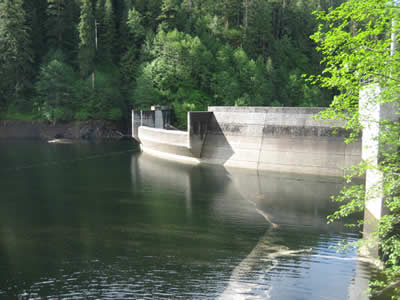Last year’s drought in southern Southeast Alaska led to low lake levels in key hydroelectric facilities. For Ketchikan, that means more-expensive diesel generators had to be used to keep the lights on.
A wetter-than-average January has helped, but Ketchikan still has to burn diesel, in part to pay back hydro-power that was sent south from Wrangell and Petersburg last summer.
Following an extra-dry summer, Ketchikan’s precipitation in October through December was about normal. That’s more than most places get, but it still didn’t make up for the summertime deficit.
January, though, was extra wet and warmer than normal. The 25 inches that fell were almost all rain, rather than snow, and filled up the hydro-generating lakes owned by Ketchikan Public Utilities.
Andy Donato is KPU Electric Division manager. He said Swan Lake and Tyee Lake didn’t get as much precipitation. And some of what did fall there was snow.
“So this is an odd circumstance where we had weeks where we were running all of our local generation and weren’t getting the water we wanted into Swan or Tyee,” he said.
Swan Lake is the primary hydroelectricity source for KPU. Tyee provides the bulk of power for Wrangell and Petersburg. Southeast Alaska Power Agency owns both of those facilities and an intertie that allows power to be shared between the member communities.

Adequate rainfall usually isn’t a problem in Ketchikan, which sees an average of about 150 inches of precipitation a year. (KRBD file photo by Leila Kheiry)
Donato said Tyee is a big lake and usually has enough water to supply power to Wrangell and Petersburg, with some to spare. Because of that, SEAPA sold 32 gigawatt hours of hydro from Tyee to Ketchikan last summer, to help reduce the need for diesel in Ketchikan.
“A gigawatt hour is a thousand megawatt hour which is a thousand kilowatt hours. So it’s an order of magnitude. It’s a lot of power,” he said.
That was great for Ketchikan, but Donato said the drought affected Tyee more than anticipated.
“Here now, at the end of the year, when the lakes are typically frozen and we’re drafting them down we can see we’ve got very high draft rates and the northern communities are going to fall short,” he said.
SEAPA determined that it had oversold Tyee’s hydro to Ketchikan by about 6 gigawatts. That means KPU has to pay back the power and help the northern partners keep the lights on.
Donato said to do that, Ketchikan is trying to not use Swan Lake power, so that hydro can be sent north.
“We started this reconciliation process, if you will, sometime around mid-January,” he said. “And we’re probably 1.5-1.6 gigawatt hours into that campaign.”
So there’s probably at least a few more months before KPU will have paid back all 6 gigawatts. That’s if the weather cooperates. Donato said the 10-day forecast doesn’t look good from a hydro-power perspective.
“This weekend, Saturday-Sunday, it’s going to be pretty cold,” he said. “But if you look at the 10-day forecast for the following week, it’s going to get even colder. So, we’re concerned.”
Because cold weather means frozen lakes and more demand for power.
In the meantime, Donato said Ketchikan is using a combination of KPU’s hydro facilities and diesel.
“We’re somewhere around 16-17 megawatts of diesel right now as we speak,” he said. “Our total load is 28.5 megawatts, so … if I take 28.5 and subtract say 17, (then) 11.5 is coming from our local hydro.”
Donato points out that Ketchikan isn’t worse off than it would have been anyway. Because if SEAPA hadn’t over-sold Tyee’s hydro last summer, KPU would have had to burn that 6 gigawatts worth of diesel then instead of now.
So, the bill from that diesel burn was simply delayed.
“The way the municipal code has diesel surcharge figured into it, it takes the amount in dollars and prorates it across six months,” Donato said.
That means for six months from the end of the diesel burn, KPU customers will see an extra charge.
Generally, Ketchikan’s power needs rely on hydro with diesel as a backup source. Donato said he has looked into other renewable sources. Solar could work on a limited basis, he said, such as for an individual home.
“Here, because the sun is so low on the horizon in the winter months and the days are so short, it would take a massive amount of cells to do something on a commercial level,” he said.
Tidal energy is still experimental. Donato said he would love for some university to conduct a study here with a prototype.
Wind turbines combined with hydro could be a better bet.
“Hydro is really, really good at holding the frequency. So if you have strong hydro like we do, and augment that with just a little bit of wind, the hydro will hold the frequency because the wind does not,” he said. “The wind picks up and drops off. The amount of power wanders quite a bit.”
Donato envisions two turbines on the back side of Gravina Island. But, like everything, it wouldn’t be a perfect solution. He estimates turbines would cost up to $4 million each, and they need a lot of regular maintenance.
On top of that, he said, everything requires a long, drawn-out permitting process.
“You know, I’m getting worried. I don’t know if there’s enough years in my lifetime to get the next permit,” he said.
So, even though alternative energy sources are under investigation, for now Ketchikan will continue to rely on hydro and diesel.






